This is the fifth weekly installment of the chicken genetics mini-series. Please check out the other articles in the series by clicking on the button in the right-hand column. The articles are intended to be read in order. If you’ve been with me from the beginning, we have covered basic autosomal dominance in our discussion of egg color genetics and incomplete dominance in our discussion of blue feathering.
This week, we will review some basic information about DNA, chromosomes, and inheritance before beginning to apply this information to our understanding of sex-linkage in chickens. While I am sure you may already know much or more of this information, I am presenting it to make sure that we are all on the same page. Please also forgive the number of pictures. I was searching Wikimedia Commons for images and found too many cool images to pass up! Next week, we will apply this information and discuss how to breed for sex-linkage.
Chicken Chromosomes
Genetics Mini-Series Article #5
DNA and Chromosomes:
DNA is a complex chain of molecules which is essentially a code that contains the directions to create a living being. Base pairs of adenine and thymine (A-T) and cytosine and guanine (C-G) appear in sequence, much like Morse code (but with four symbols because pairs could be flipped either way, i.e. A-T or T-A.) Our genetic code is spelled out in long sequences of these pairs between two supporting columns.
This long chain of DNA is unwieldy. (A stand of human DNA is six feet long!1) To organize, this long strand of DNA is coiled around little balls of protein called histones. Then, the string of DNA-and-histones are coiled and bunched up together and formed into rods called chromatids. Two chromatids together look like an X-shape, joined at the waist by a centromere. This configuration is called a chromosome.
We get one set of chromosomes from our father and one from our mother. The illustration above shows how we get one pair of chromosomes. Humans have 23 pairs of chromosomes, 46 chromosomes all together. This results in our own combination of DNA that makes us similar to our parents but also unique. I am simplifying this process immensely (I don’t completely understand it myself – there is too much to know!), but I recommend that you watch this cool video of meiosis (the creation of gametes – sex cells which become the egg or sperm) because it will remind you how awe-inspiring life is. There is a great set of lessons about cell division here and a great set of videos here.
Chicken DNA and Sex Chromosomes
Remember that we have always discussed genes in pairs. For example, last week we discussed that a chicken with blue feathers is Bl/bl because it inherited Bl from one parent and bl from the other. Where is blue on a chromosome?
Each gene is at a particular position on a chromosome. Scientists have actually mapped the chicken genome and found where each gene sits relative to the others. A gene’s location is referred to as its locus. Its locus will be in the same place in any chicken’s DNA, and it is in the same place on the DNA from the dad and the DNA from the mom. (That is why the DNA can switch segments before an egg or sperm is made, like in the diagram above, and not mess up the code – most of the time.)
As I said above, humans have 46 chromosomes, 23 from each parent. Twenty-two of these are autosomes, or non-sex chromosomes. One is a sex chromosome. In humans, females are XX and males are XY. Moms have two Xs, so all of their children get one X from them. Dads have one X and one Y, so half of their offspring get an X and half of their offspring get a Y. That is why there are about 50% males and 50% females! (The reason there are more females than males is that males have a higher mortality rate than females.)
Important Information for Understanding Sex-Linkage
Chickens have 78 chromosomes. That is, they get 39 chromosomes from each parent, and one of those is a sex chromosome. The avian sex chromosomes are Z and W. Males are ZZ and females are ZW. In birds, it is the females who are heterogametic – the opposite of humans! Female chickens have one Z and one W. The male chicken gives one of his two Z chromosomes to all of his offspring. If the female chicken gives her offspring a Z, then the offspring will be male. If she gives a W, then the offspring will be female.
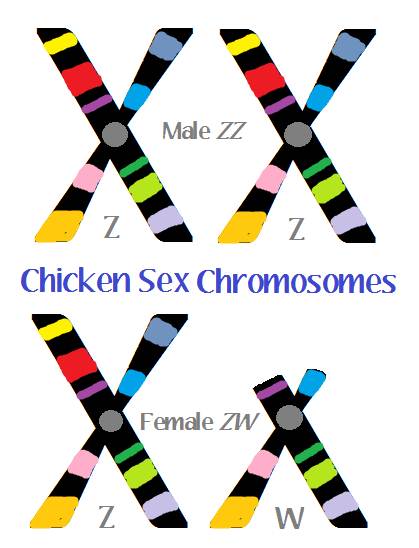 The Z chromosome contains many genes. Just as the human Y chromosome is shorter than the X, the avian W is shorter than Z. Therefore, the female chicken only has one copy of many genes because there is no second copy on W. For example, the red band above might represent a gene that occurs only on the Z chromosome. (The picture above is very over-simplified. Many genes on W have no match on Z and vice-versa; W is not just an incomplete Z.)
The Z chromosome contains many genes. Just as the human Y chromosome is shorter than the X, the avian W is shorter than Z. Therefore, the female chicken only has one copy of many genes because there is no second copy on W. For example, the red band above might represent a gene that occurs only on the Z chromosome. (The picture above is very over-simplified. Many genes on W have no match on Z and vice-versa; W is not just an incomplete Z.)
Additionally, just like a human father gives his X chromosome to his daughters and not to his sons (who get his Y), a female chicken gives her Z to her sons and not to her daughters (who get her W). This is the basis of sex linkage. If the mother gives a dominant trait, such as barring or silver color, only to her sons, then her sons will look different than her daughters if the father did not carry the same dominant trait. We will continue in this vein next week when we discuss sex-linkage.
![By Peggy Greb, USDA ARS [Public domain], via Wikimedia Commons](https://i0.wp.com/upload.wikimedia.org/wikipedia/commons/1/18/Genomic_chicks.jpg)


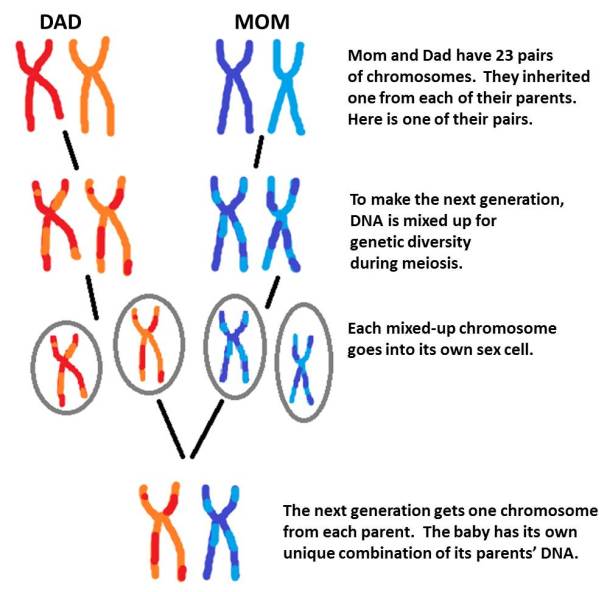

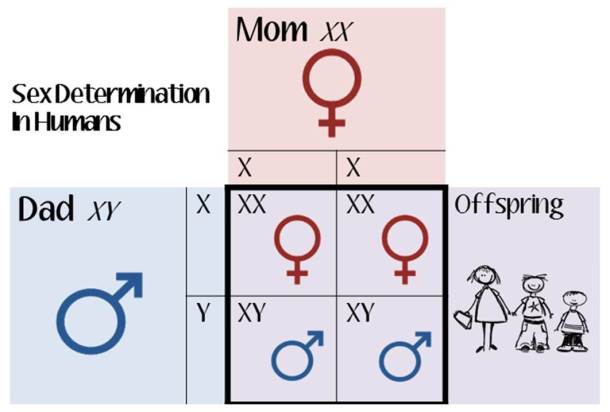
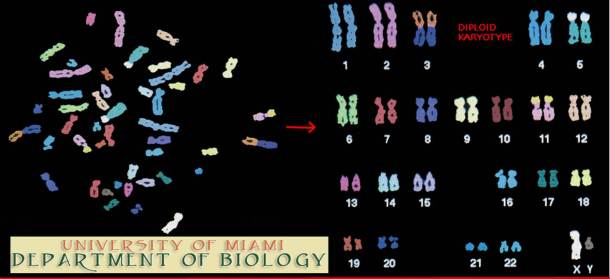
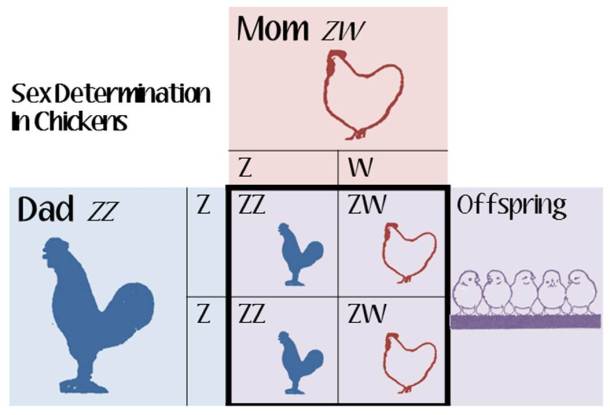
![By Graphodatsky et al. [CC-BY-2.0 (http://creativecommons.org/licenses/by/2.0)], via Wikimedia Commons](https://i0.wp.com/upload.wikimedia.org/wikipedia/commons/c/c1/Comparative_chromosome_map_of_birds_and_mammals_inferred_human_homologies_on_chromosome_idiograms.jpeg)

Pingback: Sweaty Guerrilla « The Fruity Chicken